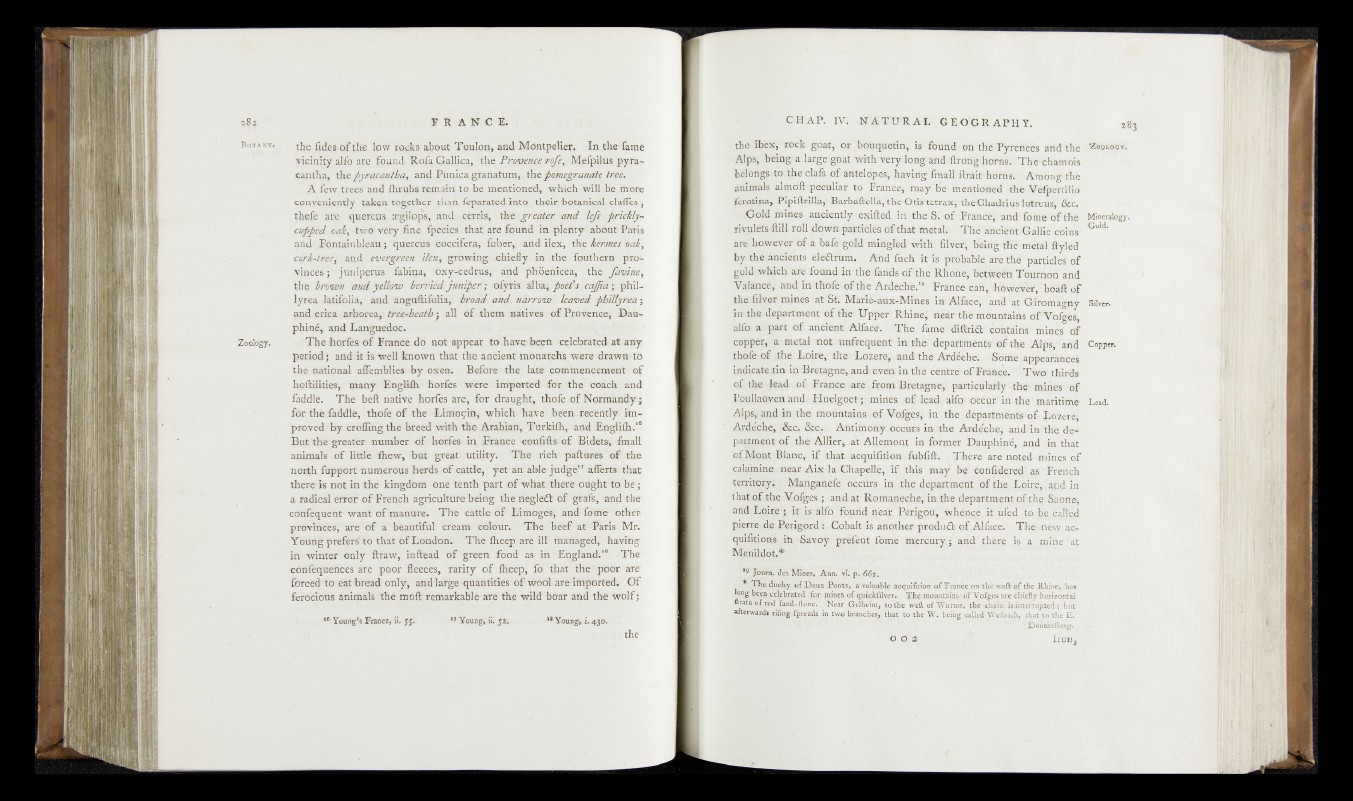
.iBI—
Ï R A N C E .
■«ÿf—î IoW ç€i«te î&brit Touloftj adiâMteti^lteï*, In fche&mè
vicinity alfo ate found Rofa.^alUqa, the ^ fm ie n ^ rp fiÿ Mefpilus pytu-
pantha, fhe pyxm antha, and Pun^âigranatunÿ, the pùmegranpte irfâ .
A few t秣sydd fhtubs resnnajn to be mentioned, Which wil-Ljhedh-ore,
■ conveniently taken-together-(than feparâtèd iritb. .their JjftSanieal claffes j
t^efe are quercuïs mgilops, and cêrris, theÉgiretife*' and dep~priekly~
cupped «<*$£}twèfvery fine fp/eriiçs that are found in plenty-ahduti'Pdris
and Fontainbleau j qüercHS çoe.dîer% fubeC,.arid Hex, ftwe kirm esbdk\
.eyétgm en tfek> growing Adiiefly m^theufoû-Éiefni.-pro*-
- Vinoèê'^^uuîperus fabina, "t>xy-tedTUS,- arid phiienlccla^rthë pu vins:,
the hdm m a v d ydbcw berried jn tà fietvi ofyris alba, poet's cajjia '$ phlls
îyrga. I4dft>ya, and an^nfiàfoHa^ broad and éa ^^ÿ& a sd d sp k& yêBU -}
and ÿte-'.arfeqreay tr é e d m A ^ d k of th em viàitives <èif P^Éï#ênêj^\ Bak^
phinéy and Languedoc.
Zoology-» T h e horfea o f Prance do not appear to have been celebrated- ait. any
period ; and it is w ed k n ow n tiidt t ^ a j d d e ^ mbnarehy w ^ fr drawn- to
th e national afferabiies b y oxen. Before.' the fate camine rieeimant ©f
hoftrlities, many ' Engltfh faorfes wet>e- imported for 'the 1 coach and
faddleV T h e beft native Tories are, Tor d ra u g h to lîo lÿ o f Normandy.;
fQC-Aèi'feèfflé^ thofe-of the Limoçin,
proved Txy eroffiing d ie breed veiA-the Arabhfr^ Tutfeiûij- :ààd Englifh.16
BmtfiejgEeatèE number c f hGefesi %,JF*aiÿ6e e o tffife àT Bidetsi,, d&mali
animals b f Mütïè ihew, b è t ^erit* utB&yy Tfe©urieirpæftitwes ©ft.tfce
north fnpport mimerons herds o f cattle* yet an aMe-j ud^é'7 a f e t a that-
there is n o t in the kkigdbHi one tenth part .©f wfeâfc there oilght^t®; b e ;
a radical error o f French agriculture being t h e t f t ^ ld ^ w
ccÉiÿqùeht- w an t c# manure. The cattle o f Mxttogêè^ hndTonfite other
pnWiBceS, are o f aT e y rtifu l ctfeaih êoîênff The bèêf at PàiisllMîV
Young prefers* to that 6 f London. T h e ïheep aré ill riia-waged, having
iri< winter only ftraw^înflfeàd' o f gréen fbod* as- in England;1* < The
ceraffiSq^hcessffè ‘ jpîbr Séeces, ' fa iitÿ o f ÏÊëéjst' fSjTh'àfj 'tfe^pdOir Wë‘
forced to e st bread: only, cariddafge quantities bfi wOcLareiriipeked'» Of'
ferocious animals ’th e moft remarkable axe the wild boar and th é Wolf ;
*yoang,8 France« ii. 55. 1 Young» ii. 52. * Young» i. 430.
I the
OHAP. iv. n a t u r a l - Ge o g r a p h y . 38’3
thOs^heSs^r Eock goat, or bouquetin,11&‘ found on the Pyrenees arid the
‘M^hei»g--®tla%ergoafi •wmhvSryloag aM^rc^gTbrri&> Thfe chamois
te ld h # toa^iehl^ofi'aistolopes, having fmaJlbftrTitTbfhs-. Amdn^.thfc
anfcnaL falmo'ft peculiar to I ranee,* rtyy be mentioned th e VefpertMid
fe^ima, ^ ip i4MiHa,«Barba-flteira,fefe Ofis fetra^.thetehaSMUis Itrtreiis- &c.
'^©^MfrhaAes. jric idH ^ f c '^ fte d m-tihe<fjypf Prance, and fom d o f the
riv^ttfsAifl; r@M^-w.feJ.pai!>fi&fes: 'd»fthat ■'Tlf&'ahfcferit Voms
areUioWe.ver'ofva feafe gold'kfdgled ' With the metal ftyled
bythelifcafehts 'ele®fliT-. • A,rid;fikthMbis p'rbBtfbte a * n h b upT-tide*gl d f
gold which1 a f o f a t a d ’inf th e 'fan ffa J^ 'th e'^ ^d iS fe /'b ^ ^ lh ToiSrhon and
ytdknGM f'mi. bdafldf
,tshe ffdvfbtoirigs 1 mrie^arixlM^bM®'AfeelHyiM^aie <3¥oitfa|T^
hnthe: department ctf the-UpperJ Rhine^ nearHhemo'untairis’
ajfitja .part df1 ancie’i j - t t ^ c e . ' '^B e f4 m e 'd iffi® -d qT ta ih s^ .tk n ^ h
copper,- a.-'metal not -unfrequent in the* depki'tmenfe-l of-the ’Albs;--arid
thesfeof vlhej hoirg, th e ,;Ldiero,< and-the Atdeehei <-Sdfhe appeafanCes
ijidf;cailretinkin^Bretiagne,' andyev^ri- in th e ‘cent-r^of Frah^.^ -Two thirds
Q f ^ - l e a d ! ©£ Trapee; are f r o m ; t a g tie,- p&^jfehlbdy'-tte'mines-'of
Pp^SaQjmn arid* &uelg®et45 .mines /oft lead*' aJlftt-soilcur!' in’ the*maritime
Alp«,-, and .in th e mountains , o f in the -depaVtiri&itb-'o^ Boiaeri|
&&&&£&&■> &&r ■ Antimony oeems -in- the Ardfeahe^ arid inrifhfe 'de^
patpo^nt ^ t h e ’Allier; a*t jn (former .D au p h i« , and in .that
o^Mprit.Blanc, i£.that-,acquifitie(a*.fubfift. 7 T hw e are- Hoted-mines-pf
calamine near >Aix-lafChapellei ifl-sthis may he'eorifidefddl as "Freriei
tyritory^ U h^anganefe. 9? tfop- - and in
th ^ ,o f the Vqfges ; an.A at' Romaneche, imthe dfepart'ment*of*the-'Saene,
u t' is ,;alfAlf|ufid|n^rfjTe^^^ whei^e’ f f u l ^ ’fnine caflfti
pierre^de, Perig^rd: Gebak is another p«®dfu£h ©ftAlfeca'. iThe^new aa-
quifi'tions iri -Savoyf-®refent fome mfrhurV,; and there 'is ’aftnffiie' at
]% hlldot*
Jpurn.^es^^nes,.v^ni^,
* o f Fspahce onjfel^ewielfe’Ctf'tBe^RIisne, bag- .
been celebrated for mines of quicidilver.. TKe'-mom^tams. o f ^ ofg.es arefe^ie^
itrataof red^fana-1 ^ . Near Gelbeira,, to t fe Weft ofWprms, tb©\ch^mo isHiiterrapte^ b i^ '
afterward» rifiBg fpreads in two] br^richiW that to the W . being .called Weftrich, that to-*t3ve Ec |
' .v ©Oiiiieriberg.
Iron,
'Zoology1,
Mineralogy.
Gold.
Silver*
Copper#
Lead.
[O p 2